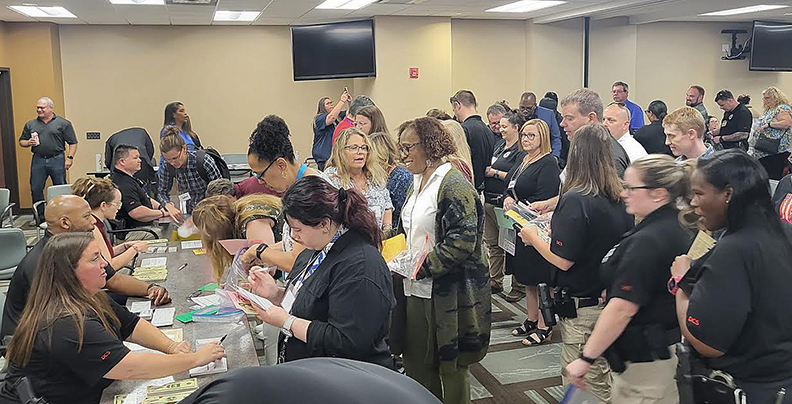Welcome!

After getting their orders to complete duties required after leaving prison, Reentry Simulation participants try to figure out where to go and then join the line there.
You've left prison, you're back in society, now what?
ASHEBORO — When James Michael was released from prison, he was dropped off in a place he’d never been with no money and no identification. His only transportation was his feet.
But through the support of people who cared, he was eventually able to get off the street, find a job and go to college. Now he’s helping others make the transition from prison to the community.
Michael told his story on June 4 to a capacity crowd at the Randolph Community College Continuing Education and Industrial Center (CEIC).
That was after most of the attendees had experienced first-hand how difficult it is for those attempting to re-enter society. It was termed a “reentry simulation.” There were 90 participants and 27 volunteers.
Each participant received a packet with a name, prison experience and other life factors. He or she was given a card with duties to perform over a four-week period. That could include meeting with probation, receiving treatment for addiction, getting a job, paying rent, buying food, taking a urine test and/or attending meetings such as AA or NA.
Around the room were tables with labels such as Bank, Rent, Tests, Plasma (to sell one’s blood), Jobs, Probation, Shelter, Food and the dreaded Jail. With everyone attempting to find the tables they needed to check off their list of duties, long lines formed.
Some, if not most, of the supposed reentry people were at a loss as to where to go next. But there was help from some in the form of Peer Support personnel.
For instance, Stephanie took “Wilson” under her wing and guided him step-by-step to check off his obligations. Before her assistance, Wilson had spent time in Jail and was floundering amidst the confusion of reentry.
But back to reality, James Michael said that when he was released from prison, he had no support from his biological family, but he found “another family” that helped him inch his way back into society.
He said those re-entering the community must have help from those who don’t judge them but treat them as human beings.
“I’ve overcome a lot,” Michael said. “There has to be change to break the link, the revolving door (of recidivism). The reentry program can stop that. I’m living proof it can work.
“If not for support and their own initiative, they’re going to do the same things (that got them into prison). If they sign up for reentry, it shows they’re determined. We change because people impact our life.”
County Commissioner Hope Hicks, who took part in the simulation, said, “The peer support helper was huge, really impactful.”
Quinton Louris, RCC Small Business director, said the school’s “partnership with the prison system is vital,” including classes being held for prisoners.
Susan Hunt, founder of Keaton’s Place, said her organization is working on transportation and temporary housing for 15 men, including those who have completed a drug program in prison. She said 33 people had been provided transportation during the past month to treatment centers, from the Outer Banks to the mountains, at no charge.
The Randolph County Veterans Services office in Asheboro is also providing help for veterans who need to re-enter society.
The Randolph Correctional Center has been designated an official reentry center. The program begins 24 months before an inmate re-enters the community.
Rob Lang, assistant US attorney, said, “Working with offenders, especially violent offenders, pays off.” He asked participants “to imagine what it would be like, with transportation issues, to (carry out duties of those re-entering society). All these issues are critical.”
Lang also encouraged the audience to “look in the mirror when you start to judge.” He said we’ve all done bad things which may not have been discovered.
Finally, Lang exhorted the various entities not to compete with each other but to “figure out how to help the families” and provide the children with stability so they won’t enter the legal system.
BrightView Health’s Asheboro center teamed up with Project Safe Neighborhood, NC Works, Goodwill, Randolph Community College, Randolph County Probation & Parole, Randolph County Vocational Rehab, Regional Communities Services Center, Randolph County Family Crisis Center, Randolph County Adult Day Reporting and Randolph County Community Navigator to kick off the introduction of Randolph County’s Reentry Council by putting on the Randolph County Reentry Simulation for the community.
Figures provided by BrightView showed that “the national recidivism rate is 40 percent and North Carolina is at 49 percent and Randolph County is even higher. The Randolph Reentry Council’s Reentry Simulation has over 75 community members, county and city leadership already registered to help reduce victimization and recidivism in the county.
“In North Carolina, 90 percent of those in the prison system will be released back into the community. Out of the 600,000 people being released from the criminal justice system in the U.S. this year, more than 400,000 will be arrested again within three years. One of the big reasons why involves active substance use disorders. Eighty-five percent of the justice-involved population have a substance use disorder (SUD).
“The goal of the event is to help the justice-involved: Getting the support they need to reduce recidivism and victimization and support the justice involved to begin the road to recovery, breaking the cycle and stigma, and making them productive members of their communities.”
For information, contact Tanya Smith at 336-707-1923 or ta.smith@brightviewhealth.com.
